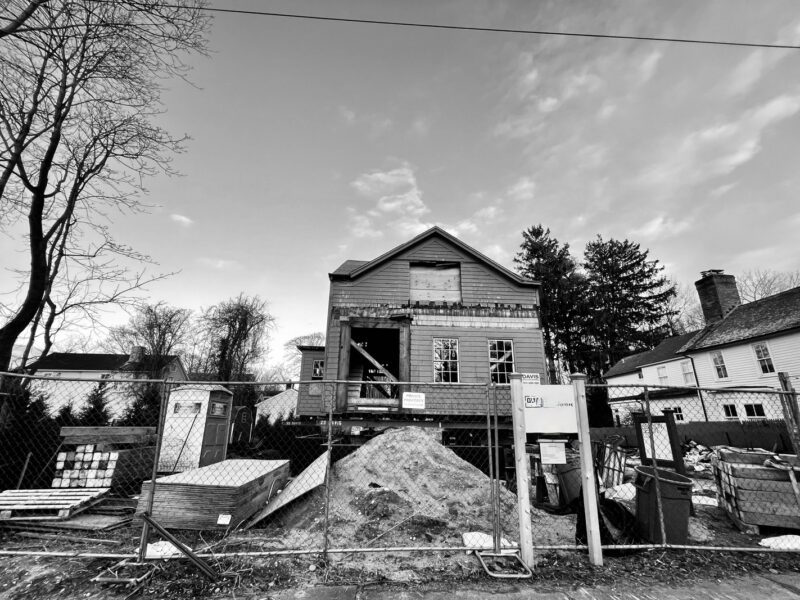
Why is it so hard for the public, developers, elected officials, planning and zoning boards, architectural review boards and commissions to come together and find consensus for a greater good? Why do lay citizens feel that they have the right to dictate what should or should not be done with a privately owned historic structure, landmarked or not? And how should new development fit into a historic district?
At the Floyd Memorial Library in Greenport this past Saturday a panel discussion, titled “Historic Preservation on the East End,” covered these topics and the current state of preservation issues. Moderated by Greenport Mayor Kevin Stuessi, the panel included Maziar Behrooz of MB_Architecture, Preservation Long Island Director of Preservation Tara Cubie and artist Sabina Streeter of Sag Harbor.
For Streeter, who lives in a whaler’s house, the topic of preservation is very close to home. It is also the subject of Floyd Memorial Library’s current exhibition, “Port + Harbor: Preservation, not Speculation,” featuring Streeter’s drawings of houses demolished in Sag Harbor alongside portraits of their owners. Streeter has lived in Sag Harbor for over 30 years and watched as historic houses have been renovated beyond recognition and gutted of all historic details inside. With the destruction of Sag Harbor’s historic houses progressing at alarming speed, she decided to document these houses in her drawings as a way of preserving them.
According to Tara Cubie, Preservation Long Island is one of the oldest nonprofit organizations in the country. Its mission involves advocacy, education and stewardship of historic sites and collections while supporting the preservation of Long Island’s cultural and architectural heritage. Preservation Long Island, for example, advocated for the preservation of the once-endangered Fordham Mill in Westhampton, which has since been restored.
Every year the organization publishes a list of endangered buildings at risk. Recently, the 1894 Queen Anne Greenport Auditorium created by suffragette Sarah Adams, designed by architect George H. Flack and built by Charles Corwin, appeared on the endangered list. Originally, the auditorium served as a theater for plays, band music and vaudeville. It later became and is currently used as a furniture store. The interior, featuring a stage with a grand curtain and balconies, remains intact. The building, which in its heyday could accommodate 700 people, is for sale and there has been much discussion about preserving it. Everyone in the village seems to have an opinion on how it should be used. While the inside of the building has no protection from alterations, Cubie noted that it is possible to write an ordinance to protect its historic interior.
Architect Behrooz discussed what happens behind landmarked facades. He observed that a streetscape in a historic district can actually look like a “still-life museum of houses.” A sense of community isn’t necessarily preserved just because buildings are. This is especially true when residents are part-time occupants.
When asked by Mayor Stuessi what he would build as a new house between two landmarked houses, Behrooz replied that the size and scale had to relate to what’s nearby while the use of natural materials also matters. As for architectural review boards, he concluded that they provide a way to prevent certain types of buildings and demographics from happening. Cubie stressed the importance of the Secretary of the Interior’s Standards for the Rehabilitation of Historic Structures. This is a gold standard of guidelines applicable for the renovation and restoration of landmarked structures and National Register historic districts.
The conversation also lurched to the raising of houses to prevent flooding. There was no discussion, however, of what severing them from their archaeological roots did to the appearance of these structures. Behrooz observed that it was important to refrain from building anything below the structure on grade so that water could be absorbed directly into the ground. Apparently, there are no laws requiring retreat, which is sometimes used as the solution for moving a house back from a flood-prone zone.
What could be done about affordable housing in Greenport Village — much of which is in the historic district — also came up in conversation. The village is considering allowing extra bedrooms to be added in house attics or third floors to create new affordable apartments. Unlike many other municipalities, Greenport has its own a municipal sewer system, so inadequate septic systems are not a barrier to affordable housing.
Behrooz also pointed out the double-edge sword regarding the Community Preservation Fund and land trust purchases of large tracts of land. Once they are purchased, more land is taken off the market and there are fewer parcels left to purchase so the cost of remaining vacant land becomes more expensive and building new becomes unaffordable.
While good ideas were suggested regarding historic preservation and use of affordable housing stock, so much of what can be achieved comes from setting priorities and having the political will to achieve those goals. The failure on the part of elected officials, residents and developers to realize that historic preservation is good for both business and community has become a prescription for killing the goose that laid the golden egg.
Anne Surchin is an East End architect and writer, vice chair of the Southold Historic Preservation Commission and co-author with Gary Lawrance of “Houses of the Hamptons 1880-1930.”